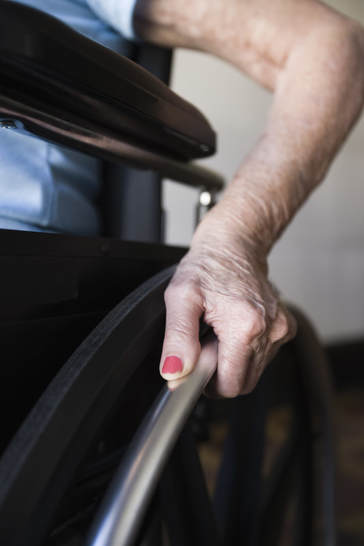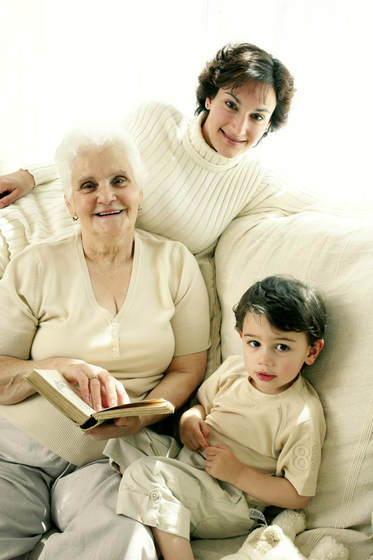Elder abuse is defined as maltreatment of an older person. Many
elder abuse victims are frail, cannot help themselves and depend
on others to provide for their basic needs. Professionals as well as family members can be
abusive or neglectful, even if they don’t always appear to be. Often the signs are not recognized, and therefore the abuse or neglect is not reported. Since the elderly are the people we frequently care for, it is important to know how to recognize the signs and symptoms.
There are several types of elder abuse and it is possible for any of
them to occur anywhere. Some of the most common include the following:
Neglect: Neglect means refusing to provide the care needed to keep the person
safe and failing to provide basic necessities. This can include failure to
provide food, water, medicines, personal care, clothing, or access to medical
care. Signs of neglect may include: Poor hygiene, weight loss or dehydration.
Physical abuse: Physical abuse means the use of physical force that may result in
bodily injury or pain. It includes such things as hitting, slapping, pinching,
kicking, shoving, shaking, or restraining someone against his or her
will. Physical abuse is the second most common type of elder abuse.
Family members, staff or other residents could cause
harm, and it’s important to be on the lookout. Signs of physical abuse may include:
Bruises, black eyes, new injuries, welts rope marks or burns.
Financial exploitation: Financial exploitation means abusing the elder by
illegally or improperly using the person’s money or property without his or her consent. Financial exploitation is the third most common form of elder abuse. This
could include: Forged signatures, disappearance of valuables or illegal withdrawal of funds.
Psychological: Also called emotional abuse means causing mental anguish, distress, and fear without using physical methods. Psychological abuse is the fourth most common form of elder abuse. The incidence is likely to be much higher since this type of abuse is harder to recognize and less likely to be reported. It can include such things as insulting, threatening,
humiliating, or screaming at the person. It can also include ignoring the person, giving the “silent treatment,” or keeping the older person away from friends or activities.
Signs of psychological abuse include: Being fearful, upset, agitated, not talking, showing childish behavior such as thumb sucking or rocking back and forth.
Sexual abuse: Sexual abuse means non-consensual (unwanted and unwelcome) sexual contact of any kind. It is much less common than other types of elder abuse. Signs of sexual abuse include: Bruising around the genitals or breasts, vaginal or rectal bleeding or stained underclothing or bedding.
Elder abuse, like other forms of violence and abuse, is a very complex issue. Almost always, elder abuse is a result of many different factors. While there is never an
excuse for abusing the elderly, there are some factors that seem to play a role. Knowing these factors can help you identify situations in which abuse may be more
likely to occur. They include the following:
1. Caregiver stress: Caring for frail, older people is a difficult task, and can be stressful. We however, have the benefit of education in dealing with the elderly and their
needs. Most family members do not have such training and they are not really
prepared to deal with the tasks that are required. This can lead to increased stress and frustration and contribute to the likelihood of neglect or physical abuse.
2. Mental and physical condition of the elder: Elders in health are much more likely to be abused than those in relatively good health who are more independent in caring for themselves. Many adult children have difficulty dealing with incontinence and having to clean up their parent.
3. Family history of violence: Some families tend to respond to stress with violence. If the caregiver has learned from childhood that violence is acceptable behavior, he or she is much more likely to abuse the elder family member. It may be that the caregiver has not learned other methods of dealing with stress and conflict. This is particularly true if the elder previously abused the child who is now in the role of caregiver for the person who abused him or her.
4. Personal problems of the abuser: Abusers of the elderly have more personality problems and/or personal problems. Be sure to: Listen to your clients. If the client tells you that
he or she is being mistreated by family members or others, report it to your supervisor as soon as possible. Know the factors that may increase the possibility of elder abuse. Learn the signs of elder abuse and watch for them in our clients. Describe any bruises or injuries you may see, not what you think may have caused them. Do not make assumptions.
If you observe what you suspect to be verbal abuse or neglect by a family member or staff member, seek the advice of your supervisor. Immediately report to your supervisor anything that makes you suspect elder abuse. Do not confront any family members if you suspect abuse. Do not tell them you plan to report them to your supervisor. Do not take signs of abuse lightly. If an elderly client tells you he or she is being badly treated, never promise them that you won’t tell anyone. In most states, healthcare professionals are required by law to report suspected cases of abuse.
It is important to note, elderly adults have the right to make decisions about their own lives. If they are mentally competent, they can refuse an investigation from Adult Protective Services or other agencies. If the client refuses an investigation into the abuse, do
not feel that you were wrong in reporting it. Your report is important even if the resident
refuses any help.
Lastly, as a reminder: You can help prevent abuse and neglect by listening to your client, intervening when abuse or neglect is suspected and educating your clients
and caregivers on how to recognize abuse and neglect
elder abuse victims are frail, cannot help themselves and depend
on others to provide for their basic needs. Professionals as well as family members can be
abusive or neglectful, even if they don’t always appear to be. Often the signs are not recognized, and therefore the abuse or neglect is not reported. Since the elderly are the people we frequently care for, it is important to know how to recognize the signs and symptoms.
There are several types of elder abuse and it is possible for any of
them to occur anywhere. Some of the most common include the following:
Neglect: Neglect means refusing to provide the care needed to keep the person
safe and failing to provide basic necessities. This can include failure to
provide food, water, medicines, personal care, clothing, or access to medical
care. Signs of neglect may include: Poor hygiene, weight loss or dehydration.
Physical abuse: Physical abuse means the use of physical force that may result in
bodily injury or pain. It includes such things as hitting, slapping, pinching,
kicking, shoving, shaking, or restraining someone against his or her
will. Physical abuse is the second most common type of elder abuse.
Family members, staff or other residents could cause
harm, and it’s important to be on the lookout. Signs of physical abuse may include:
Bruises, black eyes, new injuries, welts rope marks or burns.
Financial exploitation: Financial exploitation means abusing the elder by
illegally or improperly using the person’s money or property without his or her consent. Financial exploitation is the third most common form of elder abuse. This
could include: Forged signatures, disappearance of valuables or illegal withdrawal of funds.
Psychological: Also called emotional abuse means causing mental anguish, distress, and fear without using physical methods. Psychological abuse is the fourth most common form of elder abuse. The incidence is likely to be much higher since this type of abuse is harder to recognize and less likely to be reported. It can include such things as insulting, threatening,
humiliating, or screaming at the person. It can also include ignoring the person, giving the “silent treatment,” or keeping the older person away from friends or activities.
Signs of psychological abuse include: Being fearful, upset, agitated, not talking, showing childish behavior such as thumb sucking or rocking back and forth.
Sexual abuse: Sexual abuse means non-consensual (unwanted and unwelcome) sexual contact of any kind. It is much less common than other types of elder abuse. Signs of sexual abuse include: Bruising around the genitals or breasts, vaginal or rectal bleeding or stained underclothing or bedding.
Elder abuse, like other forms of violence and abuse, is a very complex issue. Almost always, elder abuse is a result of many different factors. While there is never an
excuse for abusing the elderly, there are some factors that seem to play a role. Knowing these factors can help you identify situations in which abuse may be more
likely to occur. They include the following:
1. Caregiver stress: Caring for frail, older people is a difficult task, and can be stressful. We however, have the benefit of education in dealing with the elderly and their
needs. Most family members do not have such training and they are not really
prepared to deal with the tasks that are required. This can lead to increased stress and frustration and contribute to the likelihood of neglect or physical abuse.
2. Mental and physical condition of the elder: Elders in health are much more likely to be abused than those in relatively good health who are more independent in caring for themselves. Many adult children have difficulty dealing with incontinence and having to clean up their parent.
3. Family history of violence: Some families tend to respond to stress with violence. If the caregiver has learned from childhood that violence is acceptable behavior, he or she is much more likely to abuse the elder family member. It may be that the caregiver has not learned other methods of dealing with stress and conflict. This is particularly true if the elder previously abused the child who is now in the role of caregiver for the person who abused him or her.
4. Personal problems of the abuser: Abusers of the elderly have more personality problems and/or personal problems. Be sure to: Listen to your clients. If the client tells you that
he or she is being mistreated by family members or others, report it to your supervisor as soon as possible. Know the factors that may increase the possibility of elder abuse. Learn the signs of elder abuse and watch for them in our clients. Describe any bruises or injuries you may see, not what you think may have caused them. Do not make assumptions.
If you observe what you suspect to be verbal abuse or neglect by a family member or staff member, seek the advice of your supervisor. Immediately report to your supervisor anything that makes you suspect elder abuse. Do not confront any family members if you suspect abuse. Do not tell them you plan to report them to your supervisor. Do not take signs of abuse lightly. If an elderly client tells you he or she is being badly treated, never promise them that you won’t tell anyone. In most states, healthcare professionals are required by law to report suspected cases of abuse.
It is important to note, elderly adults have the right to make decisions about their own lives. If they are mentally competent, they can refuse an investigation from Adult Protective Services or other agencies. If the client refuses an investigation into the abuse, do
not feel that you were wrong in reporting it. Your report is important even if the resident
refuses any help.
Lastly, as a reminder: You can help prevent abuse and neglect by listening to your client, intervening when abuse or neglect is suspected and educating your clients
and caregivers on how to recognize abuse and neglect










 RSS Feed
RSS Feed